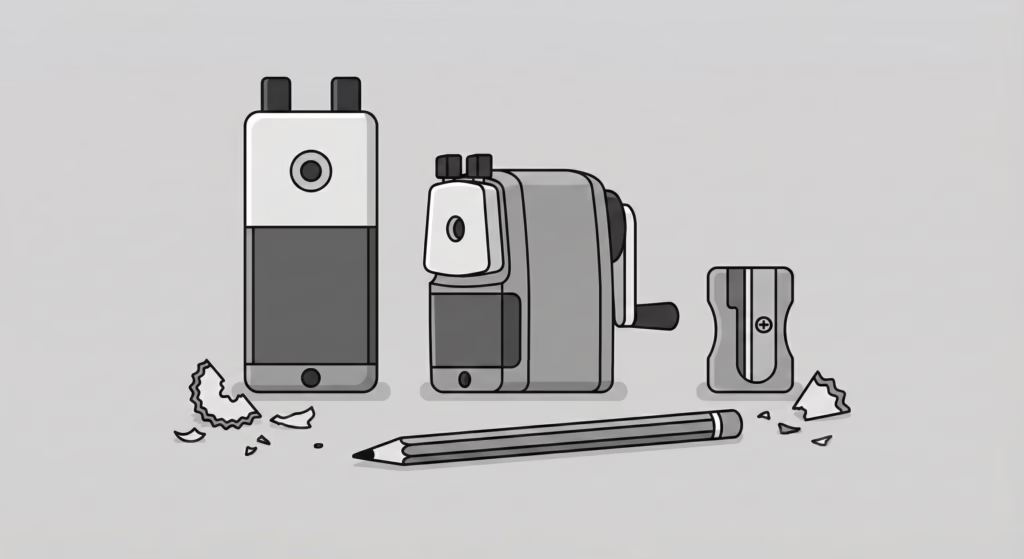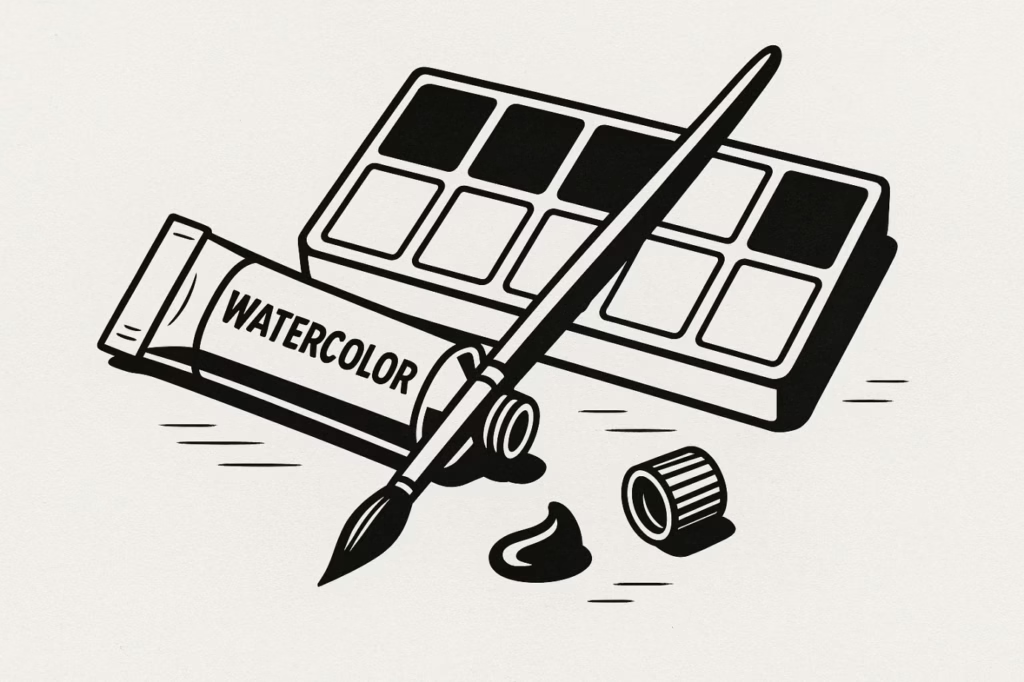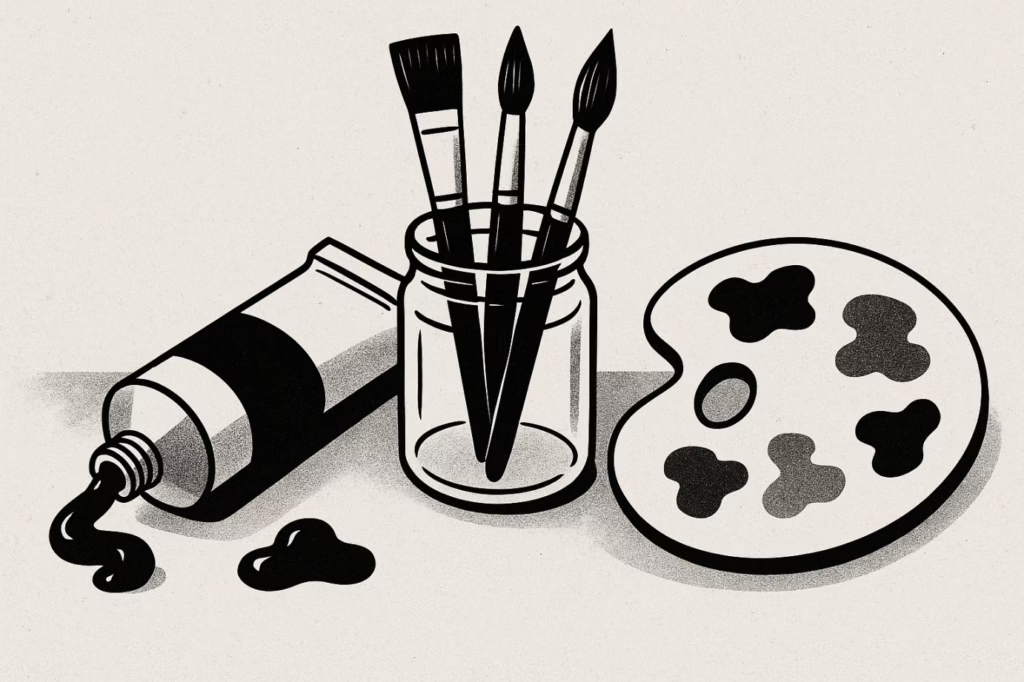Separating fact from fiction in the world of artistic mysteries
The fascination with paintings with secret codes has captivated millions worldwide, sparking countless theories about hidden messages in famous artworks. From Dan Brown’s bestselling thriller “The Da Vinci Code” to viral social media posts claiming to reveal artistic conspiracies, the idea that Renaissance masters embedded cryptic messages in their masterpieces continues to intrigue both art lovers and mystery seekers. But when we examine these alleged paintings with secret codes through the lens of modern science and art history, how much proves to be real?
The truth about paintings with secret codes is far more nuanced than either conspiracy theorists or complete skeptics would have you believe. While genuine hidden elements do exist in some artworks, the vast majority of alleged secret codes are either misinterpretations, coincidences, or outright fabrications. Understanding this distinction is crucial for anyone seeking to separate fact from fiction in the art world.
Real Examples of Paintings with Secret Codes: When Artists Actually Had Secrets
Before we debunk the myths surrounding paintings with secret codes, it’s important to acknowledge that artists throughout history have indeed hidden genuine elements in their work. These aren’t the elaborate conspiracy codes of popular fiction, but they are real, documented examples of concealed imagery and messages.
Van Eyck’s Signature Secrets
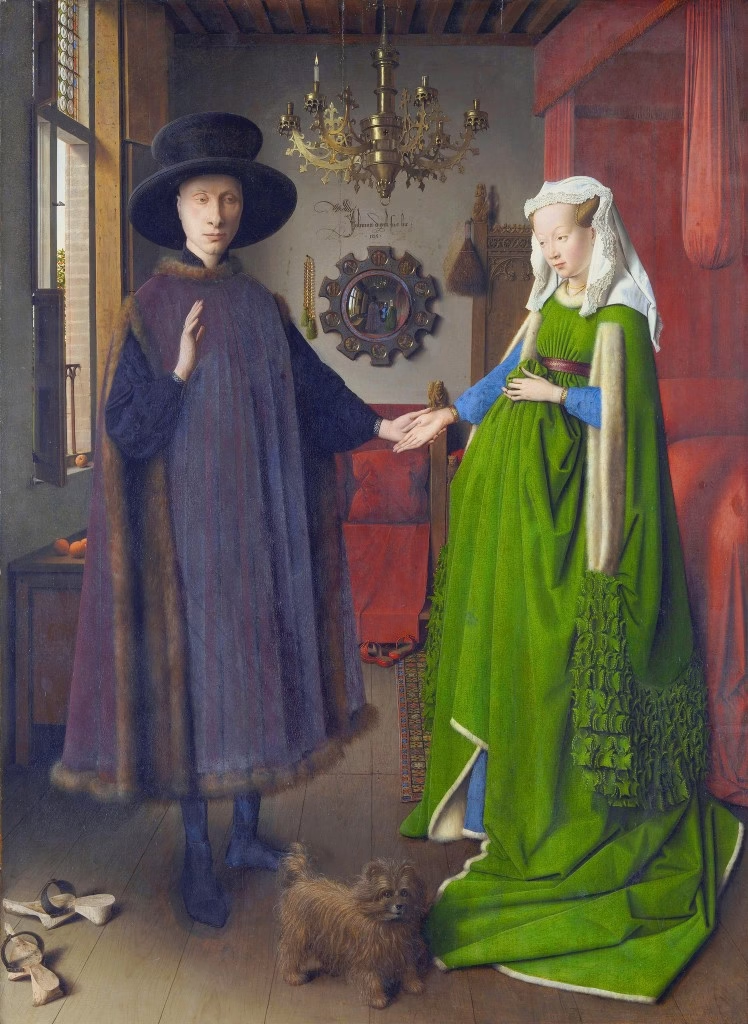
Jan van Eyck, the 15th-century Flemish master, couldn’t resist sneaking himself into his famous “Arnolfini Portrait.” In a not-so-secret act of self-promotion, van Eyck wrote “Jan van Eyck was here, 1434” on the wall in Latin behind the two figures. But far less noticeable are the other two figures in this painting. If you take a close look at the mirror on the wall, you’ll be able to spot two people who appear to be standing about where the “viewer” of this scene would be. It is widely believed that the one with his hand raised is van Eyck.
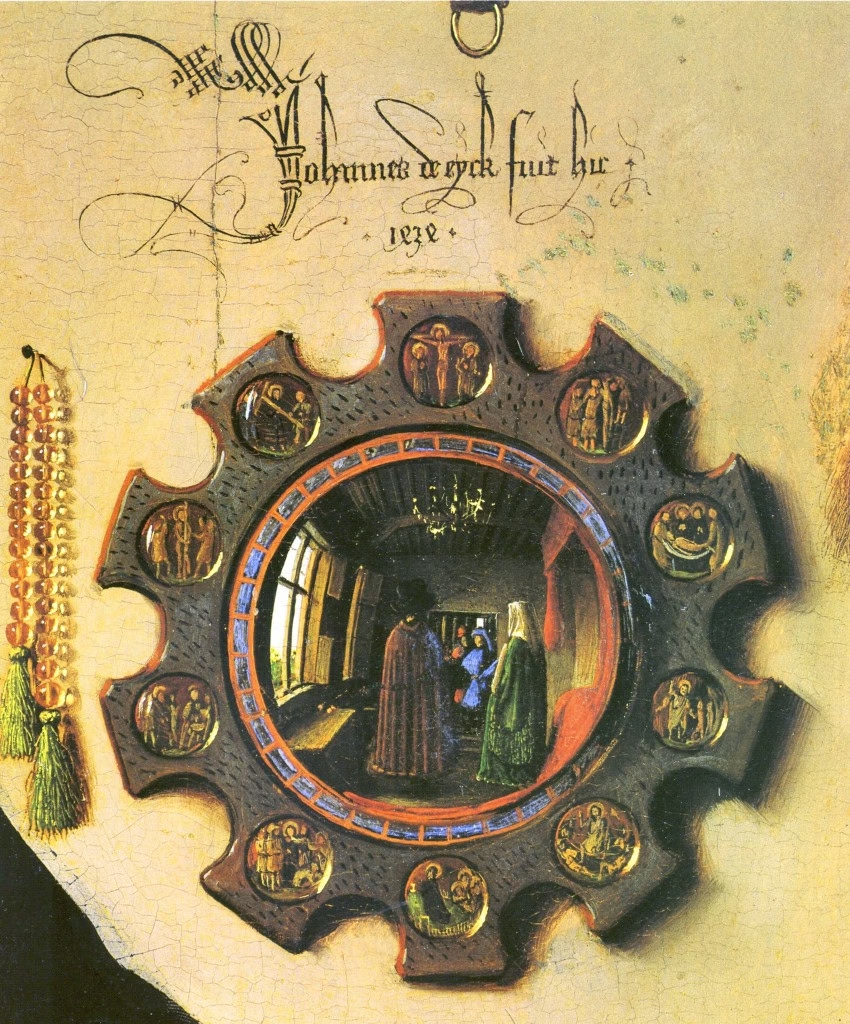
This is a perfect example of intentional hidden content – the artist deliberately included himself as a witness to the scene, documented his presence in writing, and created a clever visual puzzle that art historians have definitively solved.
Caravaggio’s Self-Portraits Revealed by Technology
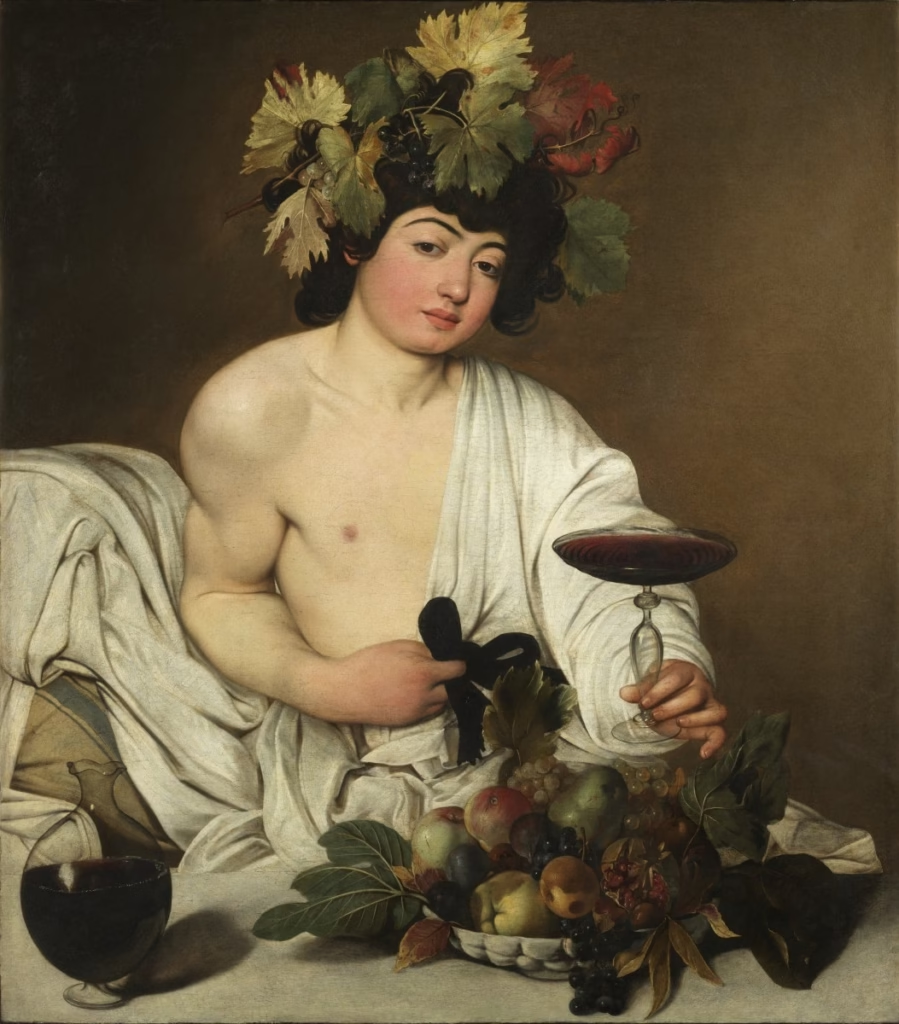
Source: Wikipedia
Modern technology has uncovered genuine hidden elements in paintings with secret codes that even the artists’ contemporaries never saw. Art historians using a technology called ‘reflectography’ discovered an image lurking under Caravaggio’s “Bacchus” painting in 2009. On the bottom left, they found a hidden image of a man sitting upright and trapped inside of the carafe. His arm points to the canvas. Could it be a self-portrait of the hard-drinking Caravaggio? Some experts believe it is Caravaggio aged 25, with dark curly hair.
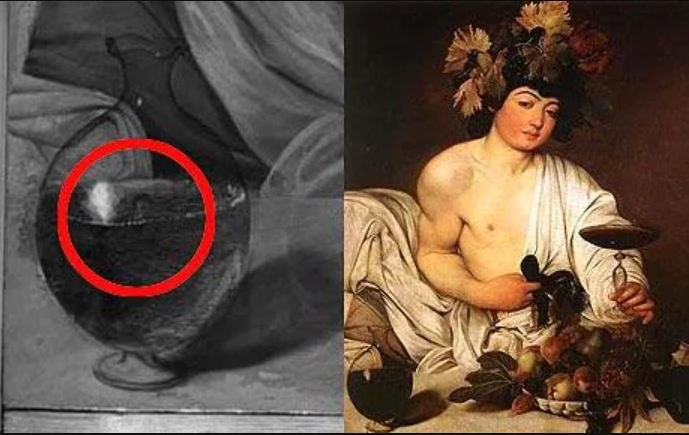
Source: Telegraph
Holbein’s Intentional Optical Illusion
Hans Holbein the Younger’s “The Ambassadors” (1533) contains one of art history’s most famous intentional hidden elements. It’s called anamorphosis, a piece of visual trickery where an artist intentionally creates a distorted image that is “reconstituted” if looked at from the right perspective. See that strange smear of white and black at the feet of the titular ambassadors? The image on the right is what it looks like when viewed “correctly.”
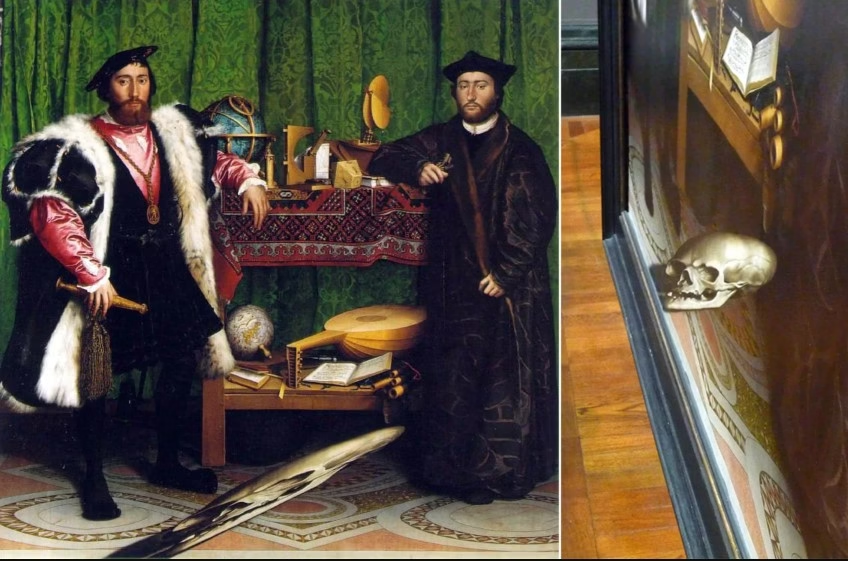
Source: pablogarcia.org
This skull, only visible when viewed from a specific angle, was Holbein’s meditation on mortality – a reminder that death comes to all, even wealthy ambassadors.
Religious Symbolism: The Original “Code”
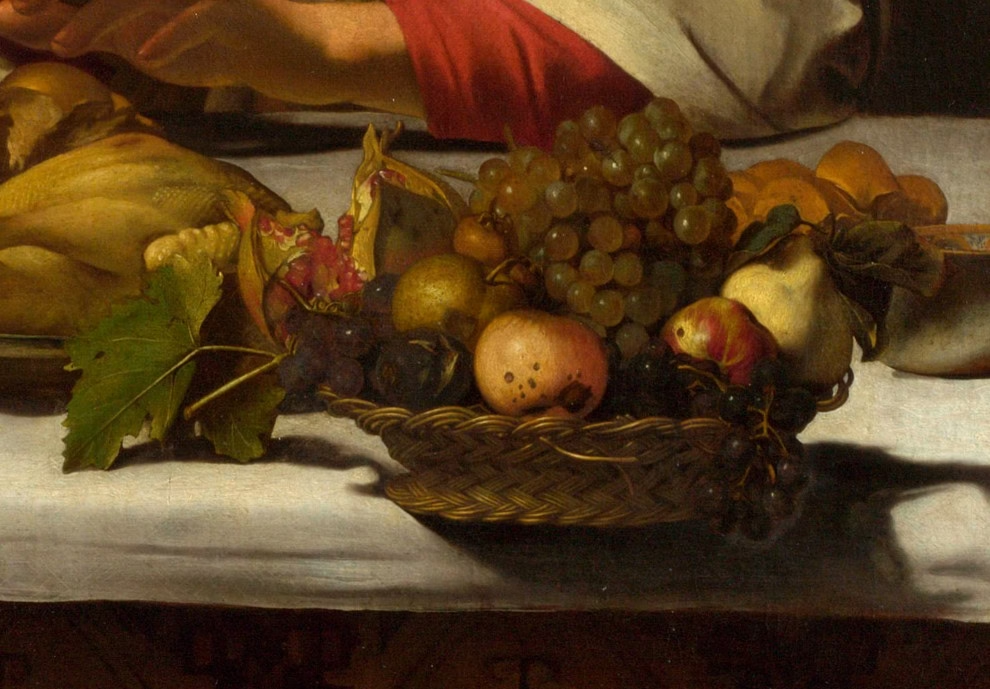
Source: Wikipedia
Many genuine hidden messages in paintings with secret codes were actually standard symbolic language that educated viewers of the time would have recognized. Caravaggio may have hidden an underground Christian symbol in “Supper at Emmaus” in the form of a loose twig sticking out from the woven fruit bowl. The frayed ends curve up and down to form the shape of a stylized fish, or ‘Ichthys’. The emblem dates back to the second century where it was a covert sign of Christian belief, used by followers who feared they would be persecuted by non-believers.
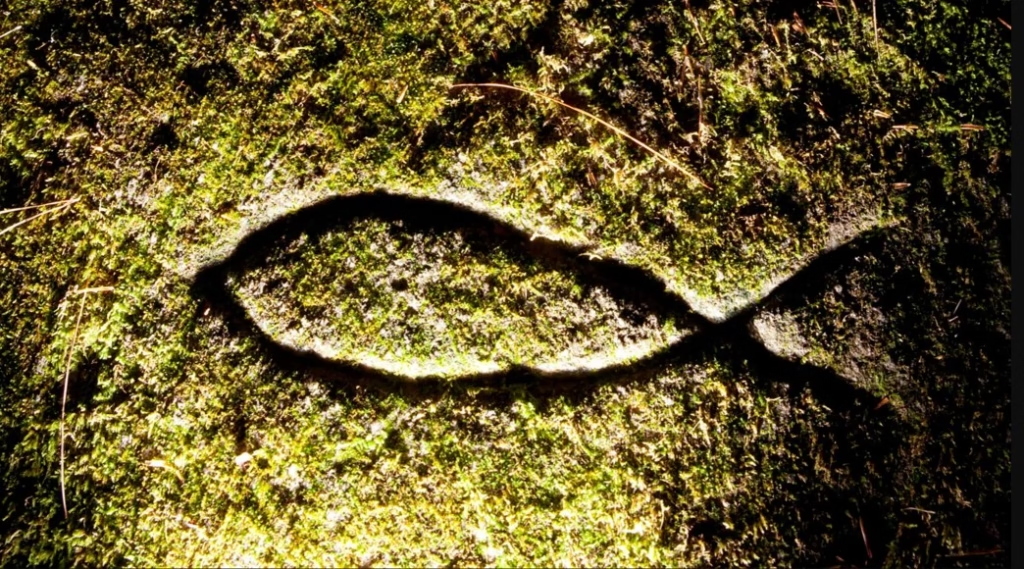
Made up of two intersecting arcs, the Ichthys symbol resembles the profile of a fish (Credit: Alamy)
Religious art has always contained layers of meaning that go beyond surface imagery, sometimes venturing into unsettling religious art territory where artists embedded controversial or hidden messages within sacred scenes.
Debunking Popular Paintings with Secret Codes Theories: The Da Vinci Code Phenomenon
The modern obsession with paintings with secret codes largely stems from Dan Brown’s 2003 novel “The Da Vinci Code.” The book’s enormous success – selling 80 million copies as of 2009 and translated into 44 languages – has profoundly shaped public perception of Renaissance art. But there’s a problem: the historical claims about paintings with secret codes in the book are largely false.
Brown’s Bold Claims About Secret Codes
Brown didn’t present his theories about paintings with secret codes as pure fiction. The novel opens with a “fact” page that states that “The Priory of Sion—a French secret society founded in 1099—is a real organization”, which is disputed. The fact page itself is part of the novel as a fictional piece, but is not presented as such. The page also states that “all descriptions of artwork, architecture, documents … and secret rituals in this novel are accurate”, a claim disputed by numerous academic scholars and experts in numerous areas.
In interviews, Brown was even more explicit. When asked by CNN’s Martin Savidge how much of the historical background was true, Brown replied, “99% is true… the background is all true”. He told ABC News that “Absolutely all of it” was factual, stating “all of the art, architecture, secret rituals, secret societies, all of that is historical fact”.
The Academic Backlash Against Secret Code Claims
Art historians and scholars were quick to respond to these claims about paintings with secret codes. Dan Brown’s novel “The Da Vinci Code” has been thoroughly debunked as being nothing but a “beach book” with no basis in reality (despite Brown’s claims of a scholarly pedigree). Brown’s become something of a joke to actual art history scholars, mainly because he made the general public start thinking there were mysterious codes and symbols in Renaissance art—and hidden meaning in art in general—when there largely isn’t.
Many theologians and art scholars dismissed Brown’s notions about paintings with secret codes. The novel, however, proved immensely popular with readers. By 2009 more than 80 million copies had been sold, and editions were available in some 40 languages.
Specific Claims About Paintings with Secret Codes Debunked
The Last Supper “Music”: A real-life computer technician, Giovanni Maria Pala, claims to have found clues leading to a 40-second musical composition in Leonardo’s “The Last Supper” – with each loaf of bread on the table representing a note of a requiem. Alessandro Vezzosi, of Tuscany’s Da Vinci museum, calls the theory ‘plausible’. However, this remains highly speculative, with no evidence that Leonardo intended any musical coding in this alleged example of paintings with secret codes.
Mona Lisa “Codes”: Experts say the barely distinguishable letters and numbers represent something of a real-life Da Vinci Code: in the right eye appear to be the letters LV which could well stand for his name, Leonardo Da Vinci, while in the left eye there are also symbols but they are not as defined. Of course, it’s very difficult to make them out clearly but they appear to be the letters CE, or it could be the letter B. Art historians remain skeptical of these claims about paintings with secret codes, noting the extreme difficulty in making out these alleged letters and the high probability of pareidolia.
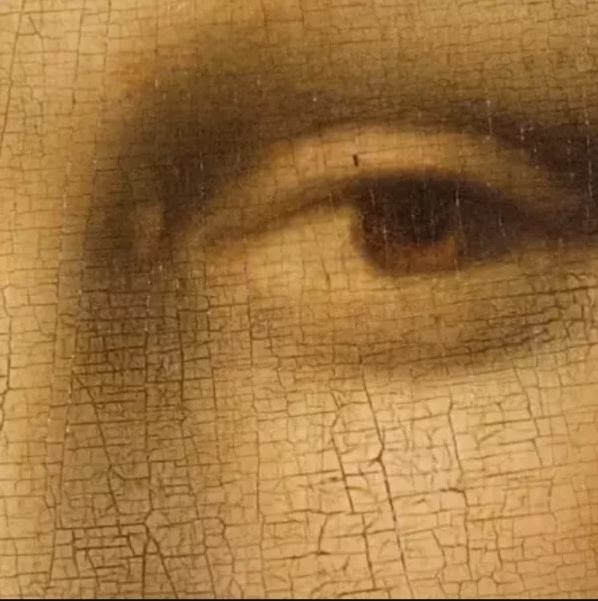
Why People Believe in Paintings with Secret Codes: The Psychology of Pattern Recognition
To understand why theories about paintings with secret codes are so persistent, we need to explore the psychological phenomenon behind them. The human brain is extraordinary at recognizing patterns – so extraordinary that it often finds them where they don’t exist.
Pareidolia: The Pattern-Seeking Mind
Pareidolia is the tendency for perception to impose a meaningful interpretation on a nebulous stimulus, usually visual, so that one detects an object, pattern, or meaning where there is none. Pareidolia is a specific but common type of apophenia (the tendency to perceive meaningful connections between unrelated things or ideas).
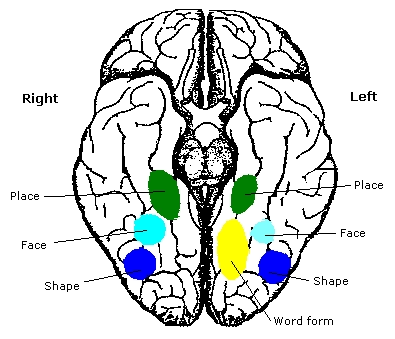
Source: Wikipedia
This phenomenon explains why people claim to see paintings with secret codes even in random brushstrokes or artistic elements. The brain’s ability to recognize faces so quickly is due to a specialized area called the fusiform face area (FFA), located in the temporal lobe.
Leonardo da Vinci Understood This
Remarkably, Leonardo da Vinci himself understood and wrote about pareidolia centuries before modern psychology gave us insights into alleged paintings with secret codes. In his notebooks, Leonardo da Vinci wrote of pareidolia as a device for painters, writing: “If you look at any walls spotted with various stains or with a mixture of different kinds of stones, if you are about to invent some scene you will be able to see in it a resemblance to various different landscapes adorned with mountains, rivers, rocks, trees, plains, wide valleys, and various groups of hills. You will also be able to see divers combats and figures in quick movement, and strange expressions of faces, and outlandish costumes, and an infinite number of things which you can then reduce into separate and well conceived forms.”
The Evolutionary Advantage
Pattern recognition is one of the mind’s most impressive tricks. It helps us make sense of a chaotic world, anticipate outcomes, and navigate social relationships. But sometimes, this superpower misfires. We start connecting dots that were never meant to be joined, spinning meaning out of randomness. This explains why people continue to search for paintings with secret codes even when scientific evidence suggests otherwise.
The history of art is filled with movements and interpretations that seem inexplicable to modern viewers, much like the bizarre art movements no one can explain, where artists created works that continue to puzzle scholars today.
Famous “Discoveries” in Alleged Paintings with Secret Codes Under Scientific Scrutiny
Let’s examine some of the most popular alleged discoveries in paintings with secret codes with a critical, scientific approach.
Michelangelo’s “Hidden Anatomy”
One of the most persistent theories about paintings with secret codes claims that Michelangelo hid anatomical diagrams in the Sistine Chapel ceiling. Some researchers believe the shape of God’s robe in “The Creation of Adam” resembles the human brain, possibly symbolizing divine intelligence. While some might dismiss this as a coincidence, experts suggest that it would be harder to explain that this was not Michelangelo’s intention. Even complex components within the brain, such as the cerebellum, optic chiasm, and pituitary gland can all be found in the picture.
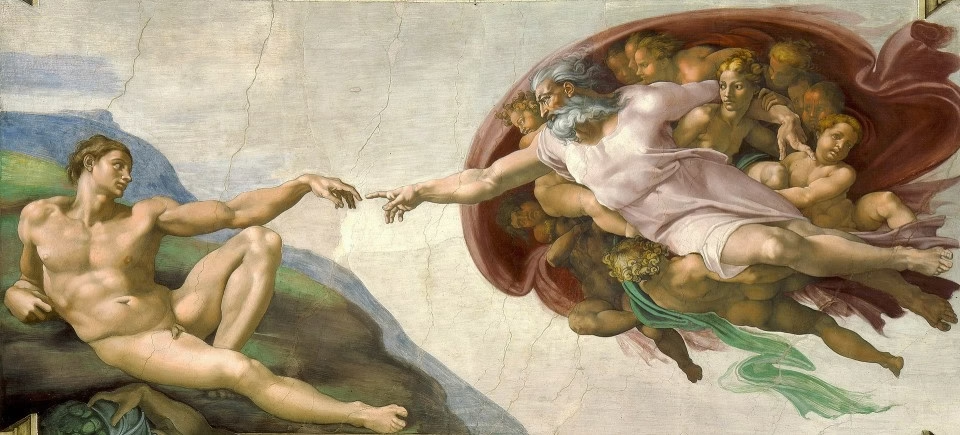
Source: Wikipedia
This theory has more credibility than most alleged paintings with secret codes because Michelangelo was known to dissect corpses and study anatomy extensively. However, it remains speculative without documentary evidence of intent.
The “UFO” in Renaissance Art
In Domenico Ghirlandaio’s “Madonna with Saint Giovannino,” arguments have been made that a UFO can be seen in the background of this painting. Above Mary’s left shoulder we observe a disk-shaped object that appears to be shining. It is an object which the artist depicted in huge detail, making sure it would stand out in his work of art.
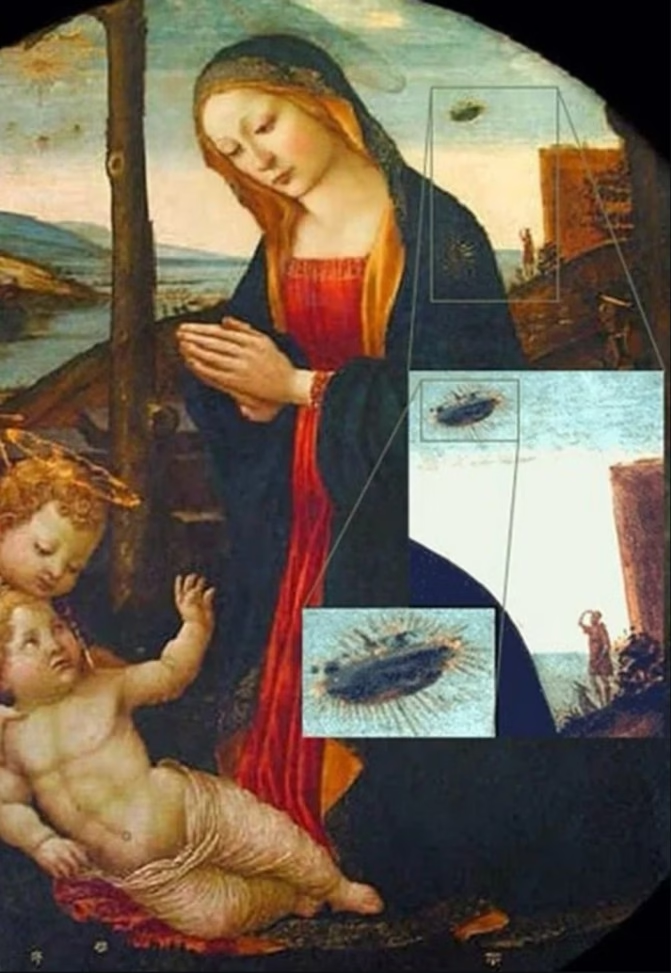
Art historians have a much simpler explanation: the object painted by Ghirlandaio could simply be his interpretation of an angelic presence or a brilliant star. After all, celestial-looking objects in religious paintings of this time were common. The “UFO” interpretation is a classic example of applying modern concepts to historical art when searching for paintings with secret codes.
Van Gogh’s “Last Supper”
Many art researchers believe that Van Gogh actually created his own portrayal of the Last Supper with “The Night Café.” Those who support this theory explain that the possibility of this painting being a depiction of the Last Supper is strong. After all, Van Gogh was the son of a Protestant minister and was very religious himself. Exactly twelve people are sitting at the cafe, all of them centered around a long-haired figure that is either their waiter or Jesus himself.
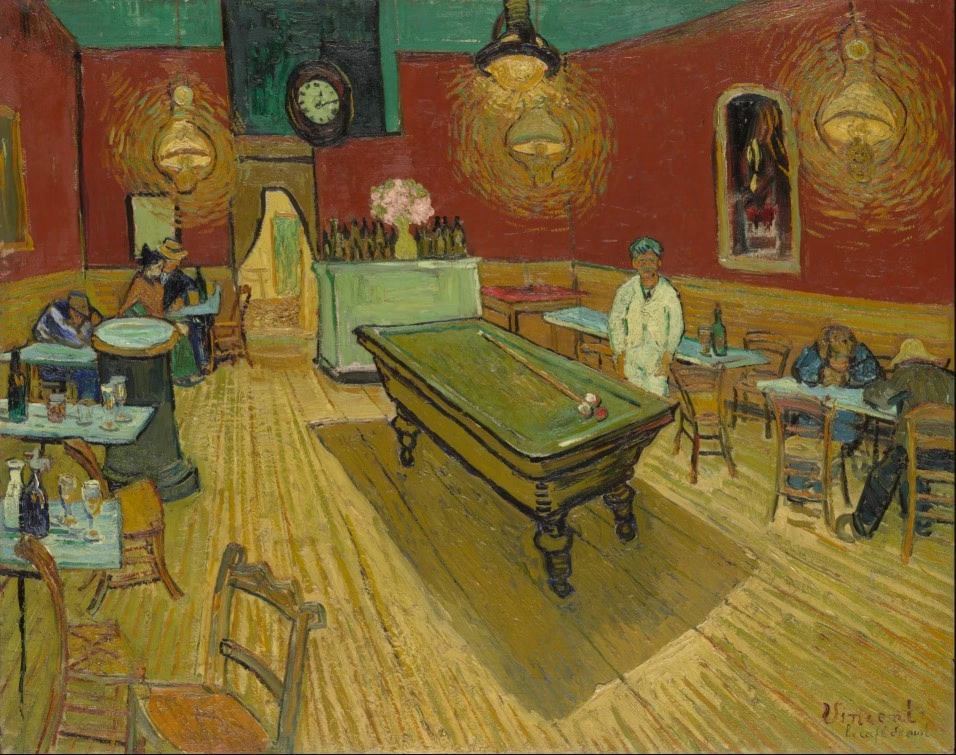
While intriguing, this theory about paintings with secret codes lacks documentary evidence from Van Gogh himself about any such intention.
Modern Detection Methods: How Technology Reveals Real Secret Codes in Paintings
Today’s technology allows us to see beneath the surface of paintings in ways that would have amazed Renaissance masters. These methods reveal genuine hidden elements in paintings with secret codes while also debunking false claims.
X-Ray and Infrared Analysis
Claude Monet’s “Wisteria” harbors a hidden secret, unveiled during preparations for an exhibition. Restorers, noticing peculiar strokes suggesting Monet’s attempt to conceal something, decided to X-ray the painting. To their astonishment, the X-ray revealed an underlying artwork featuring the water lilies that had contributed to Monet’s earlier popularity.
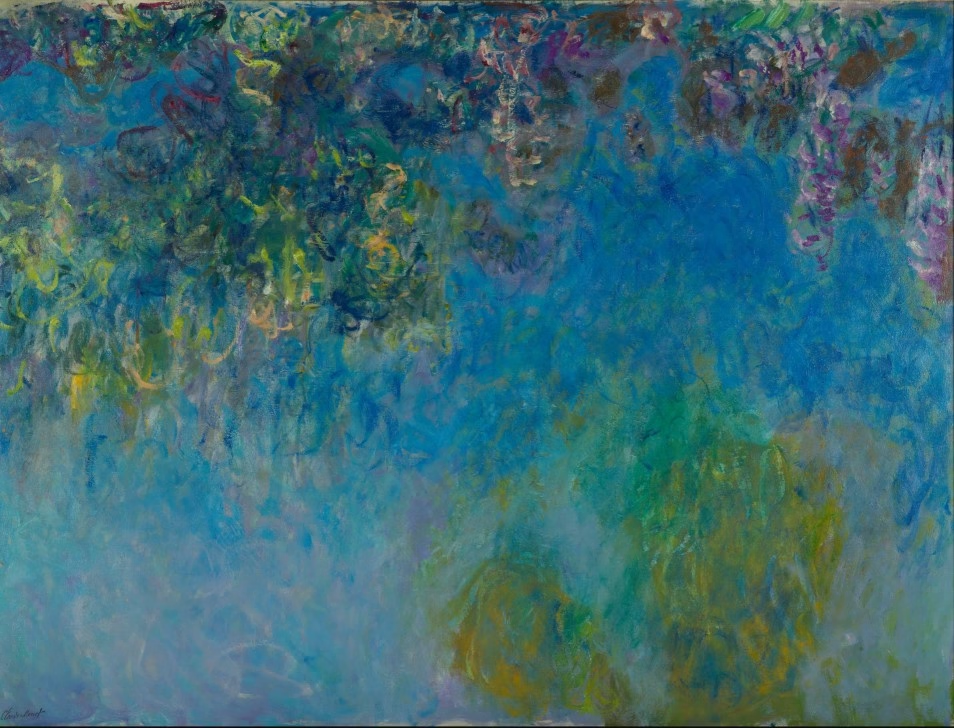
Source: Wikipedia
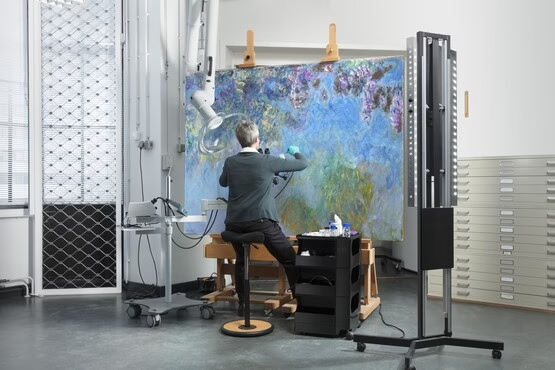
Source: kunstmuseum.nl
Reflectography Discoveries
Art historians using a technology called ‘reflectography’ discovered an image lurking under the painting in 2009 in Caravaggio’s work. This technology can reveal underdrawings, changes the artist made, and sometimes genuinely hidden imagery in authentic paintings with secret codes.
Digital Enhancement
Modern digital analysis can enhance faded signatures, reveal covered elements, and distinguish between intentional hiding and natural aging. These methods provide objective evidence rather than subjective interpretation when analyzing potential paintings with secret codes.
A Critical Analysis Framework: Evaluating Claims About Paintings with Secret Codes
When encountering claims about paintings with secret codes, art historians use specific criteria to evaluate their validity:
Establishing Pictorial Intent
The key question is: “Did the artist deliberately paint the hidden image, or is it merely a perceptual artifact?” This requires examining historical context, technical analysis, documentary evidence, and artistic precedent.
Red Flags of Dubious Claims About Paintings with Secret Codes
Be skeptical when encountering:
- Extremely complex interpretations requiring extensive mental gymnastics
- Claims that would require the artist to be psychic (predicting future events)
- Theories that ignore the historical and cultural context
- “Discoveries” that can only be seen with extreme magnification or enhancement
- Interpretations that project modern concepts onto historical art
Questions to Ask About Alleged Paintings with Secret Codes
- Does this interpretation require knowledge the artist couldn’t have possessed?
- Are similar “codes” found in the artist’s other authenticated works?
- Do contemporary sources support this interpretation?
- Could this be explained by pareidolia or coincidence?
The Real Hidden Meanings in Authentic Paintings with Secret Codes
While conspiracy-style secret codes are largely fictional, art is indeed full of genuine hidden meanings – they’re just not mysterious conspiracies.
Political Commentary
Artists throughout history have used symbolism to comment on political situations, especially when direct criticism was dangerous. During oppressive regimes, artists developed sophisticated symbolic languages to convey dissent in what could be considered legitimate paintings with secret codes.
Patron Portraits
Renaissance artists often included hidden portraits of patrons or themselves in religious scenes. These weren’t secret codes but were conventional practices that showed respect for commissioners or allowed artists to sign their work subtly.
Religious Symbolism
The extensive symbolic language of Christian art served as a form of visual theology. Every flower, gesture, and object carried meaning that educated viewers would understand. This wasn’t hidden – it was the artistic language of the time, representing authentic paintings with secret codes that had clear meanings. Even today, artists continue to embed cultural and religious references in their work, as seen in modern controversies like the Feast of Dionysus painting debate where viewers interpret contemporary scenes through historical artistic lenses.
Social Status Indicators
Clothing, jewelry, and objects in portraits carried specific meanings about the subject’s wealth, profession, and social standing. These “codes” were meant to be read by contemporary viewers who understood the visual vocabulary.
Conclusion: The Truth About Paintings with Secret Codes
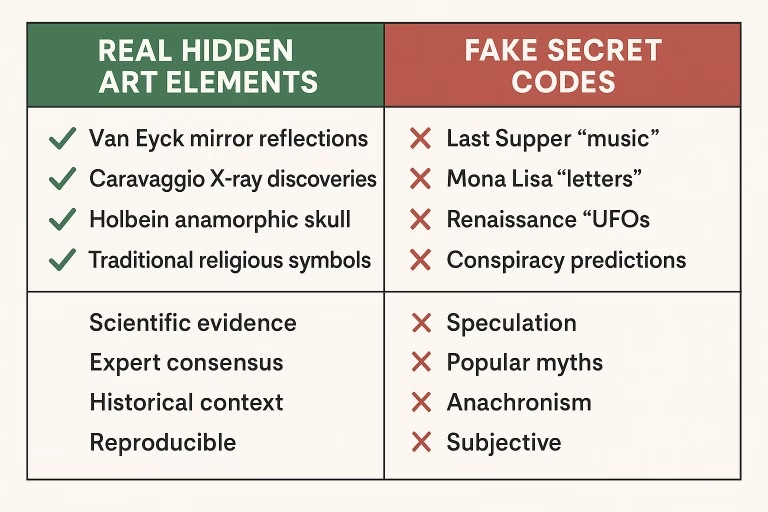
The search for paintings with secret codes reflects our deep human need to find meaning and connection. While this impulse has led to countless unfounded theories, it has also driven legitimate art historical research that has revealed genuine hidden elements and enriched our understanding of artistic masterpieces.
The evidence shows that:
- Some hidden elements in paintings with secret codes are real and documented
- The vast majority of alleged secret codes are either misinterpretations or hoaxes
- Our brains are wired to find patterns, even where none exist
- Modern technology can reveal genuine hidden layers in artwork
- Critical thinking and scientific methods are essential for distinguishing fact from fiction
The real magic of art isn’t in imaginary conspiracy codes – it’s in the genuine skill, creativity, and communication that artists have embedded in their work. Understanding the true historical context, symbolic language, and artistic techniques of great paintings is far more rewarding than chasing fictional mysteries about paintings with secret codes.
Rather than seeking sensational secrets that don’t exist, we can appreciate the actual achievements of these master artists: their innovative techniques, their profound understanding of human nature, and their ability to communicate across centuries through the universal language of visual art. That’s a mystery worth solving – and one that reveals real treasures rather than fictional codes.
The next time you encounter claims about paintings with secret codes, remember to ask the critical questions: What’s the evidence? What did the artist actually intend? And might this be a case of our pattern-seeking brains finding meaning where none was intended? The truth about art is fascinating enough without needing to embellish it with fiction.
Related Topics:
- Unsettling Religious Art: Dark Secrets in Sacred Paintings
- Bizarre Art Movements No One Can Explain
- Feast of Dionysus Painting and Modern Controversies
External Resources:

